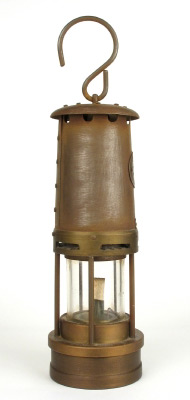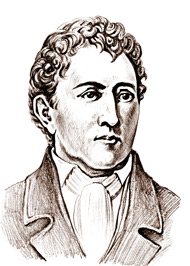Sir Humphry Davy was born 17 December 1778 in Penzance, Cornwall, United Kingdom and died 29 May 1829 in Geneva, Switzerland.
Davy’s major contributions to science include studying the physiological effects of nitrous oxide (laughing gas), isolating potassium, calcium, and other metals, inventing the miners’ safety lamp, developing the electrochemical protection of the copper sheeting of Royal Navy vessels, conserving the Herculaneum papyri, writing an influential text on agricultural chemistry, and seeking to improve the quality of optical glass.
He achieved fame as a popular lecturer at the Royal Institution in the first decade of the century, and was also known - as mentioned in George Eliot’s Middlemarch - as a poet.

Humphry Davy
Humphry Davy was the foremost chemist of his day and one of the most distinguished British men of science of the nineteenth century. Born in Penzance, Cornwall, he rose to prominence at the Pneumatic Institute in Bristol, before moving to the Royal Institution in London, and eventually becoming President of the Royal Society. He was the first to isolate the elements sodium, potassium, barium, strontium, calcium, boron, and magnesium - the largest number credited to any individual discoverer.
He wrote poetry throughout his life and was a close friend of S. T. Coleridge, Robert Southey, William Wordsworth, Walter Scott, and other literary figures. His last two books, Salmonia and Consolations in Travel: or the Last Days of a Philosopher, displayed his literary ambition and talents. Davy’s letters illuminate the major achievements of his scientific career and his relations with other leading men of science. They document his early work on natural philosophy and pneumatic medicine, under the direction of Dr Thomas Beddoes in Bristol. After Davy’s move to London, his distinguished scientific correspondents included J. J. Berzelius, H. C. Ørsted, Joseph Banks, A. M. Ampère, John Dalton, Michael Faraday, Georges Cuvier, E. D. Clarke, W. H. Wollaston, William Buckland, William Whewell, H. C. Schumacher, and Alexander von Humboldt.
The letters document Davy's work on electrochemistry and electromagnetism, mineralogy and geology, and his collaborations with other chemists such as J. G. Children and W. H. Pepys. They illuminate the controversy that initially followed his identification of chlorine as an element, and his experiments on fluorine and iodine. The experimental work leading to development of the safety lamp and the subsequent dispute concerning credit for that invention are also covered.
Davy’s correspondents also include the publisher John Murray, Francis Jeffrey (editor of the Edinburgh Review), the novelist Maria Edgeworth, and the politicians Lord Liverpool and Sir Robert Peel. His concern with the accurate publication of his discoveries, especially in the scientific and general periodicals of the day, is apparent. His travels in 1813-15 to France, Switzerland, and Italy are described, including meetings with men of science and studies of volcanoes, electric eels, and the Herculaneum papyri. Subsequent travels, including to the Austrian Alps and Italy in 1818-20, and to Scandinavia in 1824, are also documented.
The correspondence illuminates the circumstances of Davy’s election as President of the Royal Society in 1820 and his later activities in that position. The letters to Peel touch on such issues as European politics in the wake of Napoleon’s defeat, currency reform in Ireland, and the foundation of the Zoological Society of London. Alongside his scientific and business correspondence, Davy also wrote to personal friends, including Davies Giddy, T. A. Knight, John King, and Thomas Poole. These letters are notably less formal in tone and more amply descriptive of Davy’s social milieu, hobbies (especially fishing), and travels.
At the same time he also sustained a correspondence with members of his family. His letters to his mother (at least 76, almost all unpublished), to his sisters, and to his brother (and subsequent biographer) John, illuminate his family life. They demonstrate Davy’s concern for the welfare of his mother and sisters and his support of his brother’s career. More than 90 letters were written to his wife Jane, both before and after their marriage, and most of them have never been published. They reveal a previously unsuspected warmth in a relationship that contemporary observers tended to see as coldly formal. While wooing her, Davy sent Jane two of his own poems that have never appeared in print. Towards the end of his life, travelling as an invalid in Italy and Austria, he again wrote to her with extensive descriptions of his health and travels. In her own letters, Jane Davy sustained literary friendships with Murray, Scott, A. W. Schlegel, and others. She reported on a visit to Goethe in 1825, mentioned her friendships with Byron and Madame de Staël, and wrote to Sarah Ponsonby (one of the “ladies of Llangollen”) about Maria Edgeworth and Jane Austen.
This website offers the opportunity to search for letters by date, location, archive, etc. As the project continues, the letters will be checked against the originals and new letters will be added to the database as they are discovered.

